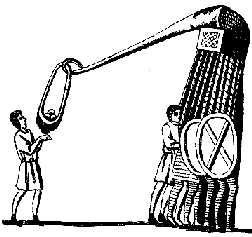
|
Part 4 |

|
Part 4 |
|
This is one of a series of pages of
Medieval and Renaissance illustrations of traction trebuchets. To avoid
problems with historical interpretation (& copyright!) as much as
possible, I have chosen to use pictures which seem to be plausibly
contemporary with the devices being illustrated. Where ever possible
the original source is cited. I have also tried to avoid what seem to
be obvious fantasy pieces. . |
| No. 13 - "Rock Hurling Engine" |

This "Rock Hurling Engine" is a redrawn miniature of the Chevalier au
Cygne (Bibl. Imp de Paris, No.340, S.F.), published in "The Arts in the
Middle Ages and the Renaissance" by Paul Lacroix, 1870
Just because a drawing is "old" (or even, if you prefer, "period"), doesn't make it accurate.
This illustration looks rather garbled, but shows a few interesting features:
The sling release (or, in this case, "non-release") doesn't engender confidence in the drawing's accuracy, but this detail may have crept in as a result of the later copying. It is taken from a miniature, after all..
| No. 14 - Palace of Piandjikent |

This drawing is of a sketch of a wall painting from the palace of Piandjikent, Transoxania. (Hermitage Museum, Leningrad) and is from the 7th - 8th Centuries.
Note the similarity to the Chinese machine shown in Illustration No. 8.
The two lines at the end of where the sling would have appeared are plausibly the same sort of double release cords seen in Illustration No.7 and Illustration No.8.
This painting is claimed to be one of the oldest representations of a traction trebuchet known.
Note also the way the crew appear to be inside the framework. Although
other interpretations are certainly possible, the positioning of the
crew within a framework also allows them to be protected by hoardings,
skins etc hung on the frame's sides. Such protection was reported to
have been used on eastern machines.
John, Archbishop of Thessaloniki, described traction trebuchets with
similarly-shaped bases in his account of the Avaro-Slavic siege of
Thessaloniki in 597, a battle in which the besiegers used 50
stone-throwing engines, or "petroboles".
(This quote taken from W.T.S Tarver's paper "The Traction Trebuchet: A Reconstruction of an Early Medieval Siege Engine".)
For the complete quotation from John's trebuchet description and a few comments, click here.
| No. 15 - Siege of Acre |

Another heavy traction trebuchet similar to the one in the simple drawing in Illustration No.9 and the machine in Illustration No.11.
The base looks like a single-post one at first glance, especially with
the wooden structure at the top of the uprights, but you can see that
the artist has drawn in the rear upright slightly higher than the front
one and the base shows this too. Note the multiple bracing timbers.
The beam is re-enforced with a lot of whipping and has a heavy cross-member at the end fitted with rings to take the pullers' ropes (which are just visible).
The artist has given the machine a huge projectile. The apparent
inward-of-vertical position of the sling is consistent with a
counterweight machine's trough launch - but I suspect the artist's
choice of position here is more to do with fitting everything into the
frame...
This drawing definitely makes the extremely large and apparently heavy end timber appear to be vertical.
(Note:
This illustration appears in "Crusades", a BBC book by Jones and
Ereira, as a counterweight machine - which it is obviously not, unless
they mean a "weight augmented" traction machine.)
| No. 16 - Tower-top Trebuchet |

The familiar single post (with multiple bracing timbers) supporting a
rectangular frame which in turn holds the axle and beam can be seen
here too.
Note the position of the machine high on a tower to maximize range and
field of fire. The use of light trebuchets, even if heavier one were in
use elsewhere, might well have been dictated by the places on defense
works available to site them.
| - NAVIGATION -
|
||||
|---|---|---|---|---|
 |
||||
 |
Previous | Next |  |
|
| Page |
|
Page | ||
 |
|---|